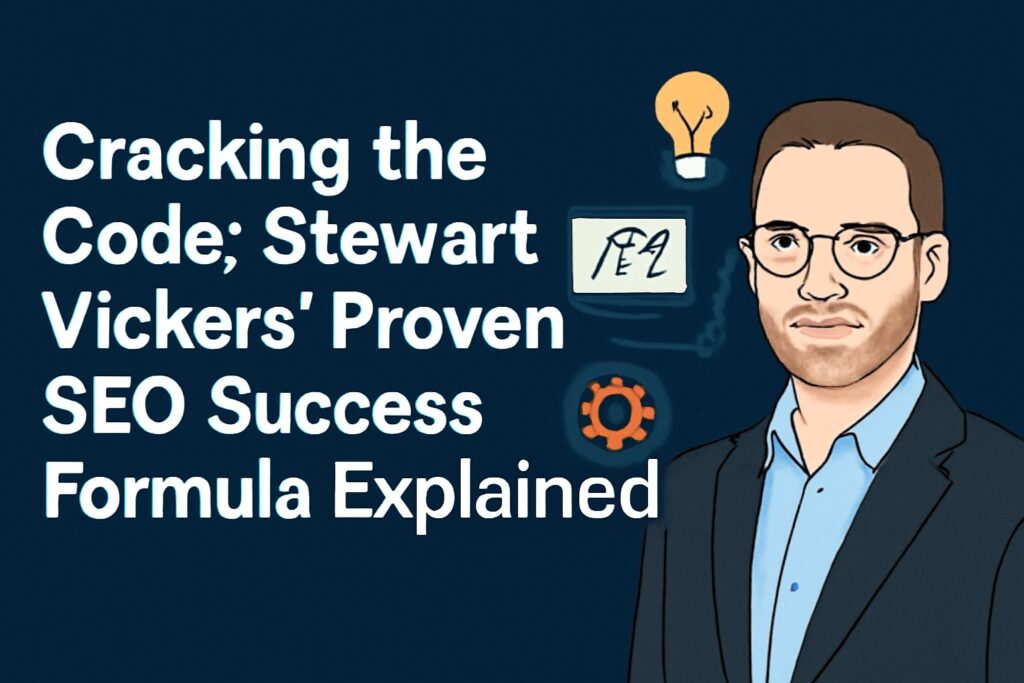Introduction: Why Stewart Vickers Deserves Attention
In an industry full of noisy tactics and recycled advice, Stewart Vickers brings clarity, discipline, and long-term strategy to the SEO game. Unlike many who chase algorithm loopholes, Stewart has built a reputation for sustainable, intent-driven SEO strategies that deliver consistent growth.
This article reveals his real formula—based on user value, systemization, and trusted digital authority.
Who Is Stewart Vickers?
Stewart Vickers is a respected name in organic marketing. He’s helped multiple businesses grow without spending heavily on ads and is known for his technical + content strategy hybrid. As of 2024, Stewart has also been actively sharing his approach on platforms like LinkedIn, YouTube, and industry podcasts.
→ Stewart’s Profile on LinkedIn
1. His SEO Philosophy: Value Before Virality
Instead of going viral, Stewart focuses on value. He follows Google’s Helpful Content Guidelines and aligns every page with what the searcher truly wants.
→ Google Helpful Content Guide
He asks:
- What are they trying to solve?
- Can my content truly help—better than the top results?
This shift from ranking-first to resolution-first is key to his success.
2. The Foundation: Intent-Led Keyword Strategy
Stewart goes beyond basic keyword research. He practices semantic keyword clustering, grouping terms based on their meaning and searcher psychology—not just volume.
He uses tools like:
→ Ahrefs Keyword Explorer
→ AlsoAsked for visualizing intent trees
→ Google Search Console to confirm actual queries
This intent-matching ensures content hits exactly what users are looking for.
3. Topic Authority: Going Beyond E-E-A-T
Instead of writing isolated articles, Stewart builds topic clusters—a hub-and-spoke model where supporting articles strengthen a central piece.
→ Google’s Search Quality Evaluator Guidelines
Each sub-article links back to the main one using semantic anchors (not generic “click here” links), helping Google understand content depth and authoritativeness.
4. Content Development: Treating Each Piece Like a Product
Every blog post Stewart creates has a:
- Defined problem it solves
- Measurable business goal
- Post-launch content upgrade plan
This mindset is influenced by product thinking frameworks like those seen in HubSpot’s content strategy.
5. On-Page SEO That Balances UX + Technical Logic
Stewart applies standard on-page tactics but does so from a UX-first perspective:
- Short paragraphs
- Descriptive subheadings
- Image alt tags that describe utility
- Schema markup (using tools like Schema.org)
His structure satisfies both human readers and search crawlers.
6. Technical SEO: Clean and Quiet
He audits sites weekly using tools like:
→ Screaming Frog SEO Spider
→ PageSpeed Insights
→ Sitebulb
Priorities include:
- Core Web Vitals
- Logical internal linking paths
- Mobile-first indexing
- Eliminating crawl budget waste
7. Link Building: Authority Through Real Content

No PBNs. No fake guest posts. Stewart builds authority through:
- Data-backed reports (e.g., content performance audits)
- Real partnerships with niche blogs
- Digital PR via platforms like HARO (Help A Reporter Out)
He believes backlinks should be earned—not traded.
8. Promotion: Multi-Platform Amplification
After publishing, Stewart promotes through:
- SEO Slack type (e.g., Traffic Think Tank)
- Content reuse for LinkedIn, Twitter, and Reddit
- Influencer sharing through email outreach and BuzzSumo
→ BuzzSumo for Content Outreach
He doesn’t wait for Google—he drives distribution.
9. Performance Tracking Beyond Pageviews
He goes deeper than typical SEO metrics:
- Conversion rate per 1K visitors
- Content ROI (SEO vs paid CAC)
- Scroll depth and reader retention
→ Uses Hotjar and Matomo for behavioral insights
→ Also integrates Looker Studio (formerly Google Data Studio) for reporting
10. Scalable SEO Systems
To scale content without losing quality, Stewart builds SOPs:
→ ClickUp SEO Content Workflow
→ Notion for Content Pipeline
Each team member has a defined role—no one wears 10 hats.
11. Unique Lessons Stewart Teaches That Most Don’t
Some fresh takes you rarely hear:
- “Less is more”—update content more than you create it
- Don’t blindly follow keyword volume—study the SERP
- Topical authority beats domain authority for long-tail SEO
These insights challenge mainstream advice—and they work.
12. Thought Leadership Built on Usefulness
You’ll often see Stewart on:
→ The SEO Mindset Podcast
→ LinkedIn SEO threads
→ SEO meetups and masterminds
He shares breakdowns, failures, and working systems—not just polished wins.
13. A Real-World Case Study: From 0 to 80K+ Monthly Visitors
One of Stewart’s clients—a SaaS brand—had zero SEO traction. After restructuring content into clusters and optimizing for user journeys, their traffic grew to over 80,000+ monthly visits, with 50+ high-quality backlinks and a 40% increase in trial signups.
This was achieved through:
- User-focused content briefs
- Internal linking architecture
- Active newsletter + social promotion strategy
Conclusion: The Blueprint Is Real—and Replicable
Stewart Vickers show that SEO fame isn’t about hacks—it’s about discipline, clarity, and repeatable systems. By direction on user needs, topical depth, and smart promotion, everyone can make long-lasting rule.
Even If you’re a freelancer, agency, or in-house marketer, his method is flexible—and most importantly, it works.
FAQs: Stewart Vickers’ SEO Formula
Q1: Where can I follow Stewart Vickers online?
→ LinkedIn: Stewart Vickers
Q2: What are the main implement he uses?
Ahrefs, Google Search Console, Hotjar, Notion, Screaming Frog, Looker Studio.
Q3: What’s the largest takeaway from his SEO come?
Intent + structure + trust = consistent SEO growth.
Q4: Does this strategy work in competitive niches?
Yes. Especially in SaaS, finance, and B2B—where authority and UX are game changers.
Q5: How is his method different from traditional SEO?
It’s built on solving problems—not just satisfying algorithms.


